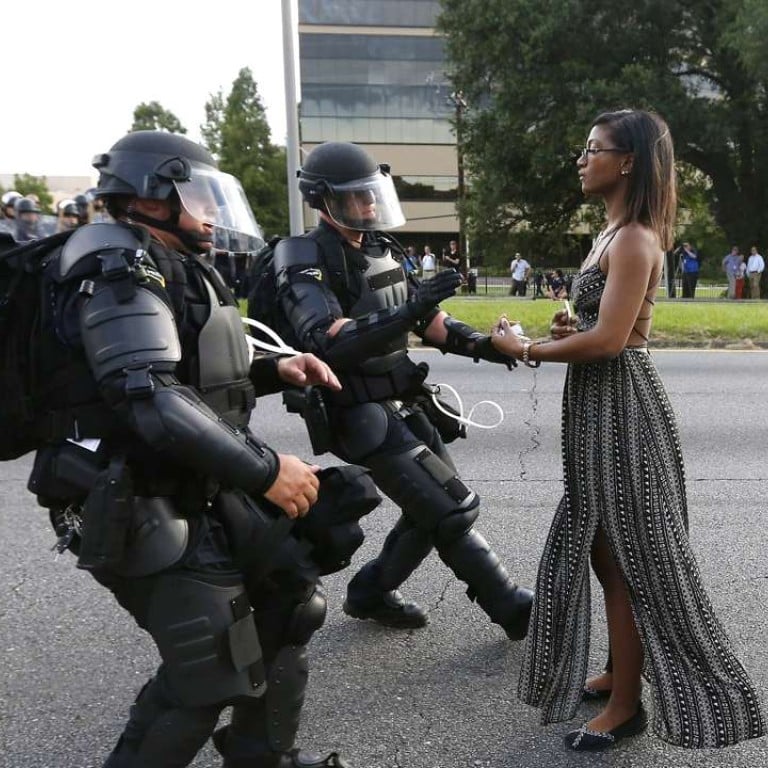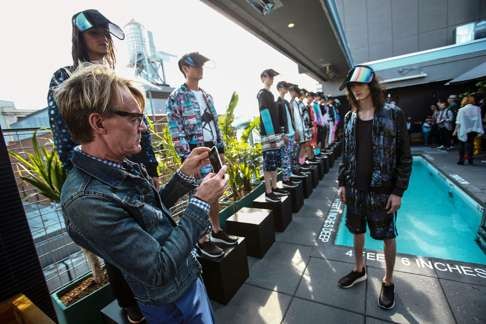
Baton Rouge, Dallas ... gender-neutral hipster chic. Can fashion reconnect with reality?
Why has the fashion industry got nothing to say about social justice, polarised politics and America’s national turmoil? And how do regular guys look in brocade suits and palm frond hats?
On the first day of New York’s celebration of spring 2017 menswear, the designers of Duckie Brown were fixated on a photograph of an elegantly dressed young woman taken2,000km away.
In their downtown studio, Daniel Silver and Steven Cox were hunched over a tiny mobile phone image of Ieshia Evans, the woman in the fluttering sundress whose steely posture was unbowed as she stood between police officers armed with riot gear and angry protesters in Baton Rouge, Louisiana, decrying the death of Alton Sterling.
No simple pair of chinos on a beanpole hipster could compete.

At the menswear industry’s opening night party, waiters passed picture-perfect hors d’oeuvres and bartenders poured booze. Common was on the bill. Cadillac sponsored it all.
The party conversation, half-heard over the fashionable din, was about which shows might be good – and which might be a bore. Folks nodded and smiled even if they only heard one-third of what was said. It didn’t matter; just small talk after all.
But then the topic changed. Dallas. They leaned in close – heads almost touching, don’t want to miss a word – when the fashion director of Neiman Marcus began to talk about the mood back in the gleaming Texas city where the company is based: Why here? Why did the shooter target our police?
Fashion – as an industry – feels disconnected from today’s news. Like some oblivious bystander. The industry en masse seems diffident. The power of its collective voice goes unused in matters of social justice, national turmoil, political pandemonium.

Instead, Seventh Avenue is busy bemoaning its own internal upheaval. Should it show you the spring 2017 collection now? Or wait until, say, April? Should it even call these collections “spring” or simply, “new clothes”?
Fashion burrows on. Its creativity may stir dreams. But will it awaken the mind? A single draped navy blazer from Duckie Brown can deliver a dissertation’s worth of detail about gender. The crispness of a cantaloupe-coloured sailing coat from Exley is a history lesson in New England manufacturing.
But mostly, fashion has just been peacocking. Suit Supply peddles tight little suits on hyper-groomed dandies. Uri Minkoff mixes tailoring with performance fabric to offer up short shorts that strain to their limit on the muscular thighs of dancers.

It might do the menswear industry a bit of good to go cold turkey on hiring so many hirsute models who are tattooed up like “The Illustrated Man”. It would serve designers well to consider how a brocade suit or a palm frond hat might look on just a regular guy. (Probably not so great.) After all, exactly what percentage of male consumers is made up of the hipster demographic?
Menswear has spent a significant amount of catwalk time touting the glories of gender-neutral clothing, feminised men’s clothes and masculine clothes that are welcoming to women. But even in the fashion crowd there is little evidence that this style has made the leap from the catwalk to the audience. Perhaps it’s yet to come. Or perhaps fashion is off the mark, just burrowing in deeper.

The week has begun uncomfortably. At Industria Superstudios, a group of not-quite-established brands presented their new lines in presentations scattered across a series of lofts. In one room, Minkoff had dancers lunging and bending in his collection of navy and cobalt blue jackets, trousers and shorts.
In another room, Private Policy had been inspired by the Associated Press’s Pulitzer-winning investigation into slave labour in the seafood industry. The collection was filled with hooks and straps and graphic illustrations. The effort was noteworthy. But the message was a muddle – a tableau of awkward young men standing around trying not to make eye contact while fashion folks swarmed around them like cocktail-buzzed bees.
The brand called Chapter used a palette of dark, dramatic tones, palm frond prints and models that made one wonder: male, female, am-I-terrible-for-even-asking?

This city’s menswear shows will be spread over four days. Innovative brands such as Tim Coppens and Rochambeau are yet to come. But larger and more influential labels such as Ralph Lauren and Thom Browne already showed several weeks ago in Milan and Paris, and designers there were still playing fast and loose with traditional definitions of gender. Gucci, for example, remains fully committed to its flounces and frippery. But then Brioni came along with a revamped logo, an ad campaign featuring Metallica and a suit silhouette defined by broad shoulders, narrow waists and the sex pheromones of men – not adolescents. So what will ultimately be New York’s message?

Duckie Brown has long been ahead of the pack in its belief that clothes are just clothes and whoever finds them appealing, whether male or female, should be able to wear them. Silver and Cox have not backed away from that sentiment. Indeed with so much topsy-turvy-ness in the business of fashion, they welcome all customers.
The only certainty is that the fashion business is evolving. Change is akin to survival. “If we want our business to be different, we have to be different,” says Silver.
And so this season, Duckie Brown showed a single look: a pair of flat-front khaki trousers that sit 24cm above the natural waist, a narrow navy blazer that has no internal structure, and a white stretch polo shirt that is cut so slim that it is inches away from being a boy’s size rather than a man’s.
The idea for a single look had been percolating for months. The duo wanted to do it last season but Cox couldn’t imagine editing his ideas from several dozen to just one. So he showed six.
“When I came out at the end of that runway show, that feeling was so exhilarating,” Cox recalls. “I felt like I was on the edge of a cliff and I was about to fall off.”
Moving from six looks to just one, was even more liberating. It also feels right for the moment.
“It’s about being quieter,” Silver says. “There’s so much noise. Too much noise.”
This look is photographed on a brown-skinned young man with a cloud of curly hair . A video offers a behind-the-scenes peek at the styling. But just when you expect more – more iterations, more fluff, more noise – Duckie Brown allows the silence to stand.
Sometimes, there’s simply nothing to be said.
The Washington Post
